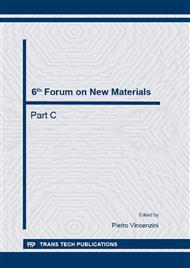[1]
H. Akinaga and H. Shima, Resistive Random Access Memory (ReRAM) Based on Metal Oxides, IEEE, Vo l. 98, No. 12, December (2010).
DOI: 10.1109/jproc.2010.2070830
Google Scholar
[2]
H. T. Lin, Z. W. Pei, and Y. J. Chan, Carrier transport mechanism in a nanoparticle-incorporated organic bistable memory device, IEEE Electron Device Lett., vol. 28, no. 7, pp.569-571, Jul. (2007).
DOI: 10.1109/led.2007.899668
Google Scholar
[3]
Prime. D, Paul. S, Overview of organic memory devices, Phil. Trans. R. Soc. A, 2009, 367(1905), 4141-415.
DOI: 10.1098/rsta.2009.0165
Google Scholar
[4]
M. Liu and J. Chen, Organic Programmable Resistance Memory Device Based on Au/Alq3/gold nanoparticle /Alq3/Al structure, ', IEEE Electron Device Letters., vol. 32, no. 8, Pp. 1140-1142, August (2011).
DOI: 10.1109/led.2011.2158055
Google Scholar
[5]
I. Salaoru, S. Paul, Non-volatile memory device- using a blend of polymer and ferroelectric nanoparticles, ', J. Optoelectron. Adv. Mater. 10 (12) (2008) 3461.
Google Scholar
[6]
S. Paul, A. Kanwal, M. Chhowalla, memory effect in thin filmes of insulating polymer and C60 nanocoposites, Nanotechnology. 17 (2006) 145- 151.
DOI: 10.1088/0957-4484/17/1/023
Google Scholar
[7]
A. Kanwal, S. Paul, M. Chhowalla, MRS Proc. 830 (2005) 349.
Google Scholar
[8]
Qi-Dan Ling , et all , Nonvolatile Polymer Memory Device Based on Bistable Electrical Switching in a Thin Film of Poly(N-vinylcarbazole) with Covalently Bonded C60, Langmuir, 2007, 23 (1), p.312–319.
DOI: 10.1021/la061504z
Google Scholar
[9]
D. C. Kim et al, Improvement of resistive memory switching in NiO using IrO2, Applied Physics Letters. 88(2006) 232106.
Google Scholar
[10]
M.A. Gondal, awfik A. Saleh, Q.A. Drmosh, Synthesis of nickel oxide nanoparticles using pulsed laser ablation in liquids and their optical characterization, Applied Surface Science, 258 (2012) 6982-6986.
DOI: 10.1016/j.apsusc.2012.03.147
Google Scholar
[11]
M. Nowsath Rifaya, T. Theivasanthi*, M. Alagar , Chemical Capping Synthesis of Nickel Oxide Nanoparticles and their Characterizations Studies, Nanoscience and Nanotechnology 2012, 2(5): 134-138.
DOI: 10.5923/j.nn.20120205.01
Google Scholar
[12]
K. Wongsaproml and S. Maensiri, Synthesis and structural characterization of nickel oxide nanoparticles synthesized by Polymerized complexed (PC) method,. IEEE. 2010, 978-1-4244-3544-9.
DOI: 10.1109/inec.2010.5425049
Google Scholar


